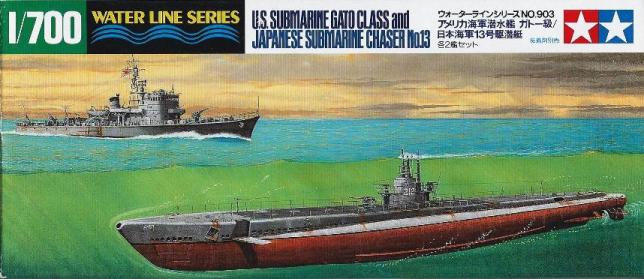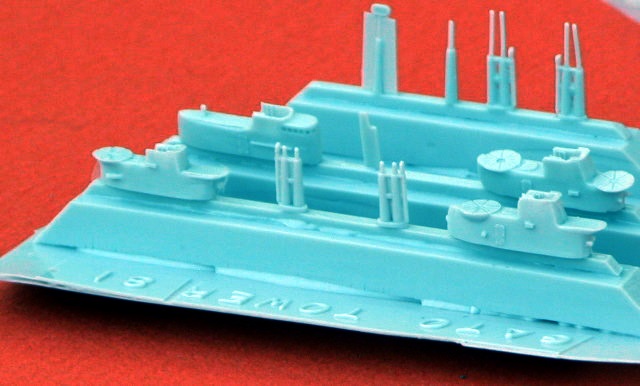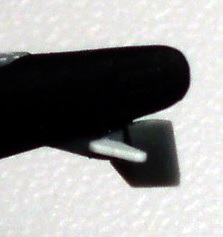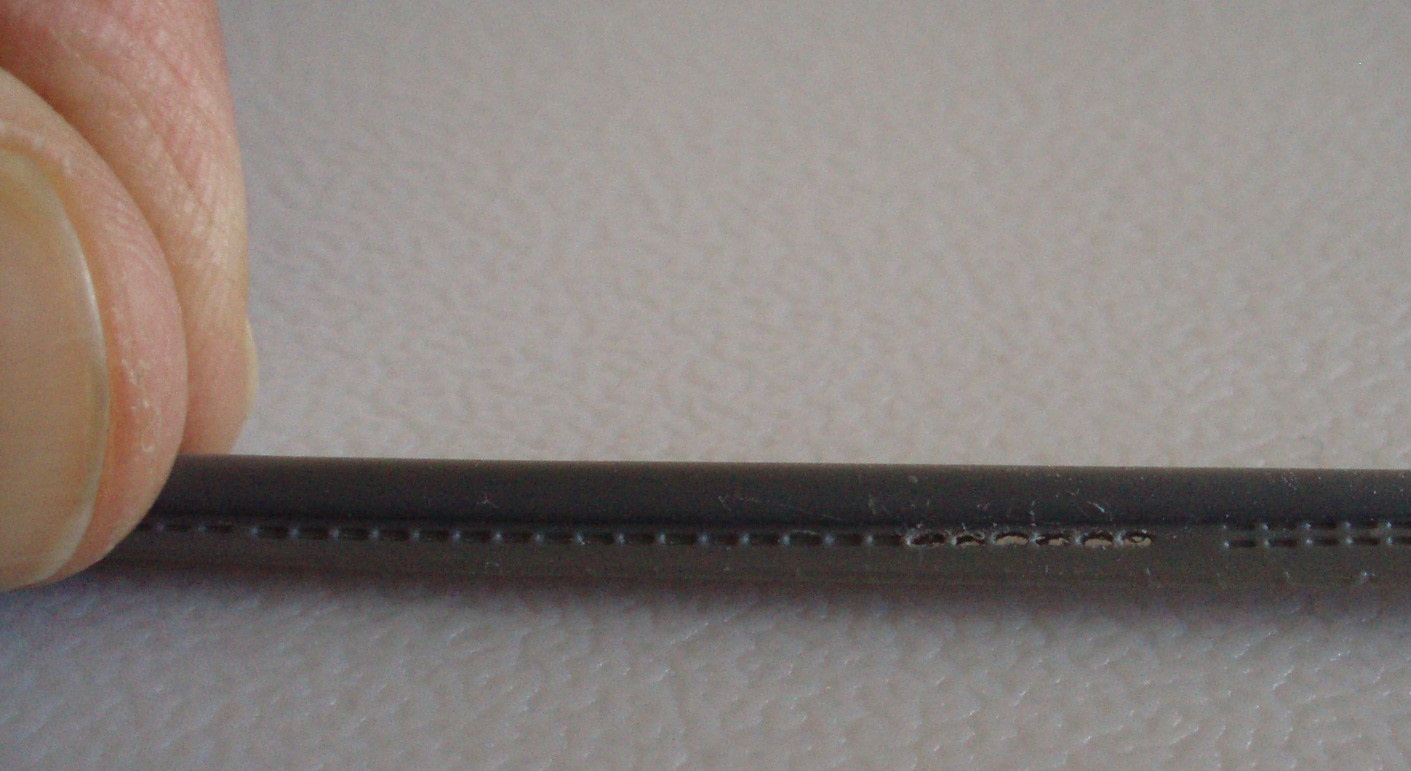 cool diorama in and of itself.'
cool diorama in and of itself.'Building 'Pinned,' an undersea warfare diorama
(UNDER CONSTRUCTION)
I originally bought this kit (Tamiya No. 31903) solely for the B-24 bomber
inside, for another diorama idea. But once I got the parts trees out, the rusty
wheels inside the ole' brain started turning and I thought, 'This would make a
really cool diorama in and of itself.'
cool diorama in and of itself.'
What sealed the deal was IMEX display case no. 2531, a 4 1/2-inch square by 8-inch high clear plastic column. Careful measuring showed that the US Navy Gato-class submarine included would fit on the base, if placed at an angle, and there would be no problem with the 2 3/4-inch long IJN No. 13 Class Submarine Chaser - if it was suspended halfway up the clear plastic display cover on its own sheet of plastic, to give at least 200 'scale' feet of separation between the two opponents.
Thus was born the idea of 'Pinned,' showing a US submarine pinned to the bottom of the ocean floor while a Japanese subchaser depth charged it from above. I decided to depict a generic encounter rather than a specific moment in time, to save me from wading through the records. I settled on the mid-1944, early-1945 time frame because I liked the cool Measure 32/3SS-B camouflage scheme with all its counter-shading that came into use for US subs at that time.
The Imperial Japanese Navy built 15 of the basic No. 13 Class Submarine Chasers from 1939-42. They were small vessels, just 167-feet long, and lightly armed: a 3-inch deck gun, four (by 1944) anti-aircraft guns, and the main reason for their existence, two depth charge roller racks off the stern and two Type-94 Y-gun depth charge throwers, for the 36 depth charges they carried. At only 16 knots top speed (about 18 mph), they were not even as fast as some of the submarines they were supposed to be hunting. Only four survived the war.
The Gato-class submarine was the US Navy's first genuinely combat-capable submarine of World War II, replacing the inter-war "letter" classes. Big, at 311-feet long and more than 1,500 tons, the Gatos could make up to 21 knots on the surface and 9 knots submerged. Six torpedo tubes forward and four aft gave them a potent punch. The 77 built did such an admirable job of choking off Japan's logistical lifeline - it's merchant marine fleet - that they undoubtedly shortened the war; 20 were lost. The final tally showed that of the 10 million tons of military and merchant shipping lost by the Japanese during WW II, US submarines accounted 54 percent. Crucially for the US, more than 5 million tons of that was merchant marine ships - 1,423 merchant vessels, 256 tankers, and hundreds of smaller inter-island cargo types.
Fun With Photoetch
I bought the Tom's Modelworks photoetch set, No. 741, that is made specifically for this kit, because many of the molded-on details on both ships are just plain clunky. Although Tom's PE itself is, in general, very good, the instructions usually leave something to be desired. Oftentimes the modeler has to puzzle out which miniscule bits go where. This was such a case.
As far as the subchaser went, Tom's admitted that they didn't have detailed information on what kinds of depth charge racks were used, so they provided the same ones as for their IJN destroyer kits. All well and good, except: The aft deck of a subchaser is quite a bit smaller than that of a destroyer. Some serious trimming was in order - which impaired the structural integrity of the PE, which necessitated more gluing and do-overs. And the PE racks for the centerline depth charge Y-guns didn't even have a way to keep the depth charges inside them, once assembled! More fiddling with little bits of plastic.
Things were a little better for the submarine PE, but not much. Again, it was a matter of puzzling out which bits of PE went where, although the directions gave a little more guidance than for the subchaser. The worst part of the submarine PE was the railings around the two gun platforms on the sail. Suffice it to say that getting straight, flat photoetch to assume a round shape is always challenging. Getting straight, flat, photoetch railings to assume a round shape while also angling outward is damnnearimpossible. Maybe that's the reason Tom's Modelworks provided so many extras ... and that's all I've got to say about that.
Which Sub?
Each of the Gatos, and the follow-on Balao
and Tench classes (which were virtually identical from the outside), went through a bewildering variety of
design changes, upgrades,
refits, etc., during its life. With more than six dozen subs to choose
from, over a four-year period, well ... I made the command
decision to model what I thought would look the best. Let
it be a puzzle for future generations.
changes, upgrades,
refits, etc., during its life. With more than six dozen subs to choose
from, over a four-year period, well ... I made the command
decision to model what I thought would look the best. Let
it be a puzzle for future generations.
The first thing that had to go was the sail. The Tamiya kit is OK in general, but the molds are decades old and the sail is basically a smooth lump of plastic. I decided I wanted gun platforms both fore and aft; while the Tamiya kit allows for that, the moldings are very overscale and the top of the conning tower is another solid lump of plastic, devoid of detail.
 I could have scratchbuilt something but,
happily, Loose Cannon
Productions offers a conversion kit that has four sail options. How sweet is that? No trying to hollow out the
existing sail or scratchbuild a new one with thin sheets of plastic. Highly recommended if
you get one of the Tamiya/Skywave Gato sub kits. As a bonus, it includes two
more upper hull halves, if you have a mind to make a diorama with submarines and their tender. I did decide
to use the kit's periscope sheers and radar mast, though.
I could have scratchbuilt something but,
happily, Loose Cannon
Productions offers a conversion kit that has four sail options. How sweet is that? No trying to hollow out the
existing sail or scratchbuild a new one with thin sheets of plastic. Highly recommended if
you get one of the Tamiya/Skywave Gato sub kits. As a bonus, it includes two
more upper hull halves, if you have a mind to make a diorama with submarines and their tender. I did decide
to use the kit's periscope sheers and radar mast, though.
Not fun was chiseling off the Tamiya sail.
First to go were the four sets of grossly-overscale "aztec" steps.
Then it was a slow, laborious process to work my way around the sail, managing to
break the deck into several smaller pieces as I did so. Once done, there was
some delicate sanding to try and preserve the nicely-molded deck planking. I had
to glue a styrene strip underneath to reinforce the deck after I pieced that
area back together, and hope that the glossy black paint on the deck
would hid my introduced imperfections.
That settled, I started on the upper hull.
Which, being a WW II-era sub, has limber holes in the outer hull to let the
water pass freely through to the inner pressure hull.
Lotsssss of holes. Which presented a dilemma. Trying
to drill out some of the smaller elliptical holes with my pin vice and No. 80
drill bit cost me two drill bits broken, for only six holes reamed
out (see the photo for the pathetic details). And were
you really going  to be able to see them all that well anyway? I settled for
drilling out some of the larger and more prominent ones around the bow, adding
some missing ones around the forward diving planes, and
filling in the rest with one of my wife's black
0.25mm drafting pens.
to be able to see them all that well anyway? I settled for
drilling out some of the larger and more prominent ones around the bow, adding
some missing ones around the forward diving planes, and
filling in the rest with one of my wife's black
0.25mm drafting pens.
Although the Tamiya kit was state-of-the-art for its day, it does simplify some things - and leave others out completely. One of the simplified things was the previously-mentioned sail and conning tower. One of the left out things, I eventually realized, was the aft diving planes, although they are shown on the boxtop art. Good thing I'd found some detailed Gato-class plans on the internet!
Another thing that was a far bigger pain to add were the bilge keels on each side of the lower hull. These strips of steel are found on virtually all warships, and are intended to keep them from rolling too much. I had to get out my contour gauge and make a cardboard template to match the hull curve. The end result was, for me, predictably messy but looked OK thanks to a lot of super glue and the fact that the lower hull is all dull black. Whew!
Historical Note: A total of 52 US submarines were lost during WWII, almost all of them in the Pacific, and virtually all of them with all hands. The final resting place of some of the 1,505 US submariners who gave their lives remain unknown to this day - they remain on "Eternal Patrol."
This page was last updated June 23, 2018.